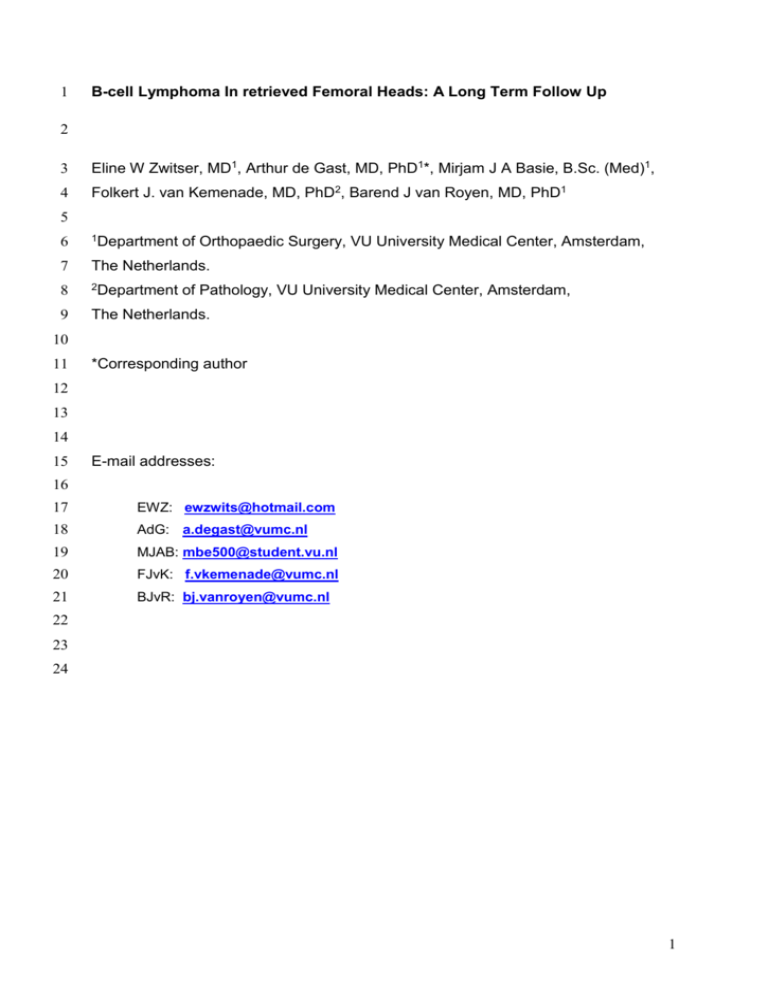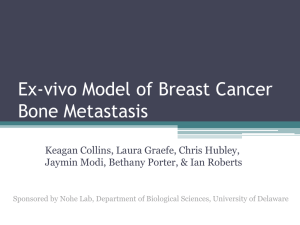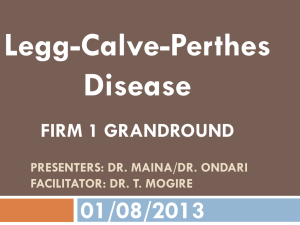Long term follow up in patients with B-cell lymfoma
advertisement

1 B-cell Lymphoma In retrieved Femoral Heads: A Long Term Follow Up 2 3 Eline W Zwitser, MD1, Arthur de Gast, MD, PhD1*, Mirjam J A Basie, B.Sc. (Med)1, 4 Folkert J. van Kemenade, MD, PhD2, Barend J van Royen, MD, PhD1 5 6 1Department 7 The Netherlands. 8 2Department 9 The Netherlands. of Orthopaedic Surgery, VU University Medical Center, Amsterdam, of Pathology, VU University Medical Center, Amsterdam, 10 11 *Corresponding author 12 13 14 15 E-mail addresses: 16 17 EWZ: ewzwits@hotmail.com 18 AdG: a.degast@vumc.nl 19 MJAB: mbe500@student.vu.nl 20 FJvK: f.vkemenade@vumc.nl 21 BJvR: bj.vanroyen@vumc.nl 22 23 24 1 25 Abstract 26 27 Background A relative high incidence of pathological conditions in retrieved femoral 28 heads, including a group of patients having low grade B-cell lymphoma, have been 29 described before. At short term follow up none of these patients with low-grade B- 30 cell lymphoma showed evidence of systemic disease. However, the long term follow 31 up of these patients is not known. 32 Methods From November 1994 up to and including December 2005 we screened all 33 femoral heads removed at the time of primary total hip replacement 34 histopathologically and included them in the bone banking protocol according to the 35 guidelines of the American Associations of Tissue Banks (AATB) and the European 36 Association of Musculo-Skeletal Transplantation (EAMST) We determined the 37 percentage of B-cell lymphoma in all femoral heads and in the group that fulfilled all 38 criteria of the bone banking protocol and report on the long-term follow-up. 39 Results Of 852 femoral heads 14 (1.64%) were highly suspicious of low-grade B-cell 40 lymphoma. Of these 852 femoral heads 504 were eligible for bone transplantation 41 according to the guidelines of the AATB and the EAMST. Six femoral heads of this 42 group of 504 were highly suspicious of low-grade B-cell lymphoma (1.19%). At long 43 term follow up two (0.23%) of our patients developed systemic malignant disease 44 and one of them needed medical treatment for her condition. 45 Conclusion In routine histopathological screening we found variable numbers of low- 46 grade B-cell lymphoma throughout the years, even in a group of femoral heads that 47 were eligible for bone transplantation. Allogenic transmission of malignancy has not 48 yet been reported on, but surviving viruses are proven to be transmissible. In addition 49 patients with neoplastic histopathological findings need monitoring and follow up. 2 50 Therefore we recommend the routine histopathological evaluation of all femoral 51 heads removed at primary hip arthroplasty as a tool for quality control, whether the 52 femoral head is used for bone banking or not. 53 54 Key words: B-cell lymphoma, bone allograft, histological examination 55 3 56 Background 57 58 Allograft donor bone is successfully used in reconstructive tumour surgery and 59 revision of total hip arthroplasties [1,2]. Bone banks collect femoral heads according 60 to the safety procedures of the American Associations of Tissue Banks (AATB) and 61 the European Association of Musculo-Skeletal Transplantation (EAMST) [3,4]. These 62 constantly updated guidelines are of the utmost importance in order to prevent the 63 transmission of infectious diseases. Despite these extensive procedures there have been recent publications of 64 65 living cells within donor tissue after routine cryopreservation [5-7]. The potential risk 66 of transmission of diseases from donor to recipient by these surviving cells remains 67 uncertain, but there have been several reports on the development of infectious 68 diseases due to the transplantation of contaminated allograft bone [8-14]. Previously, 69 we and another group recommended routine histological examination in the 70 screening protocol because of a relative high percentage of pathological conditions in 71 retrieved femoral heads, including a group of patients having low grade B-cell 72 lymphoma [15,16]. At short term follow up none of the patients with low-grade B-cell 73 lymphoma in the femoral head showed evidence of systemic disease. However the 74 clinical consequences of these findings remained unknown. Therefore we continued 75 our prospective study to screen all retrieved femoral heads after total hip arthroplasty 76 histopathologically, including those that were not suitable for bone banking. We 77 determined the percentage of B-cell lymphoma in all femoral heads and in the group 78 that met all criteria of the bone banking protocol and report on the long-term follow- 79 up. 80 4 81 Patients and methods 82 From November 1994 up to and including December 2005 all femoral heads 83 removed at the time of primary total hip replacement were collected according to the 84 guidelines of the AATB and EAMST [3,4]. All patients gave written and signed 85 informed consent. They were screened by a questionnaire in regard to 86 their medical, social and sexual history. The questionnaire was based on pre-existing 87 forms, followed the guidelines of the AATB and EAMST, and was written in the 88 national language; the patients were interviewed by a doctor. In 89 addition, a thorough physical and routine blood examination was performed. Blood 90 was collected to determine the blood group and Rhesus factor, white blood cell count 91 and screening tests were performed to exclude syphilis, HBV and hepatitis C virus 92 (HCV), cytomegalovirus (CMV), HIV1 and 2 and HTLV type 1. An increased ESR 93 was also used as a criterion for exclusion. All donors were retested for HIV1 and 2, 94 syphilis, HBV, HCV and HTLV1 six months after the donation taking into account the 95 negative window period. 96 After resection of the femoral heads, swabs from bone and capsule were taken for 97 aerobic and anaerobic cultures. A core bone biopsy specimen (1 cm3) and a part of 98 the capsule were retrieved for histopathological examination. Cores or biopsies were 99 in general too big for electrolytical decalcification, as is routine in the laboratory for 100 trephine biopsies, but were decalcified in Kirstensen’ solution in a daily controlled 101 fashion. After decalcification, biopsies were routinely processed and microscopy was 102 performed on Hematoxylin and eosin. In case of suspicion (ie lymphocytic collections 103 that were monotoneous) additional stains and immunohistochemistry was performed 104 to confirm diagnosis and, if possible, classify. 5 105 Grafts were stored at – 80˚C and 6 months later another blood examination followed. 106 We earlier described our bone bank screening procedure in detail [15] 107 Femoral heads of patients who were excluded somewhere in this bone banking 108 selection process were sent for routine histopathological examination only. 109 Non Hodgkin Lymphoma was diagnosed according to routine diagnostic procedures 110 in the laboratory by expert hematopathologists. Criteria were an increase in lymphoid 111 cells in general variable between interstitial pattern of infiltration, or paratrabecular 112 localization of two or more nodules to packed marrow of cells with short chain 113 restriction (kappa or Lambda) and uniform B-cell marker (CD20, CD79a, CD23 114 expression). In case of concomitant elevated peripheral white blood cell counts, CLL 115 was diagnosed. 116 We determined the percentage of low-grade B-cell lymphoma in all femoral heads 117 and in the group that was suitable according to the bone banking protocol. Patients 118 having low-grade B-cell lymphoma in the femoral head were referred to a 119 haematologist-oncologist for further evaluation. Follow up of these patients consisted 120 of clinical and radiological assessment on a yearly basis, reviewing hospital files and 121 contacting family doctors. We assessed if patients had symptoms of systemic 122 disease and if they were treated by other physicians. 123 6 124 Results 125 From November 1994 to December 2005 we obtained 852 femoral heads removed at 126 the time of primary total hip replacement from 737 patients (205 men, 532 women), 127 mean age 69 years (Range 23 to 94 years). We reported earlier on 137 of these 128 femoral heads [15]. Fourteen of 852 femoral heads were highly suspicious of low- 129 grade B-cell lymphoma (1.64%). These fourteen femoral heads were retrieved from 130 13 donors. Mean age of these donors was 67 years (Range 51-79 years) 131 Of 852 femoral heads, 504 fulfilled all criteria for donation according to the existing 132 guidelines of EAMST and AATB. 348 Femoral heads were discarded, because of 133 either a positive donor history (questionnaire), an increased ESR, or positive 134 serological, histological or bacterial tests; if malignant disease was diagnosed within 135 six months of donation. Some femoral heads have been rejected because of 136 incomplete information from the screening tests. Six of 504 allografts were excluded 137 based solely on the histopathological features of B-cell lymphoma (1.2%) These 6 138 femoral heads were retrieved from 6 different donors. These femoral heads were 139 excluded from clinical use and donation. 140 We found variable numbers of low-grade B-cell lymphoma throughout the years. 141 The distribution of low-grade B-cell lymphoma for each year is shown in figure 1. 142 We performed a long term follow up, median follow up 7.2 year (Range 1-12 years) 143 In long term follow up one patient developed a B-cell lymphoma in a lymph vessel in 144 the inguinal region on the contralateral side, 3 years after the histopathological 145 diagnosis low-grade B-cell lymphoma was established. She underwent a lymph node 146 excision and started with chemotherapy and radiotherapy. Currently this patient is 147 stable (non-progressive disease) for 3 years but still monitored by a haematologist- 148 oncologist. 7 149 Another patient developed chronic lymphatic leukaemia. There was no treatment 150 indicated, she is under the supervision of a haematologist-oncologist. Three other 151 patients are still being controlled on a yearly base by a haematologist, however they 152 did not develop malignant disease so far. 153 8 154 Discussion 155 In routine histopathological screening of 852 femoral heads we found 14 low-grade 156 B-cell non Hodgkin Lymphoma (NHL) throughout the years. Even in the group of 504 157 femoral heads that were eligible for bone transplantation 6 femoral heads were 158 suspicious of low-grade B-cell lymphoma. We have performed a long term follow up 159 of these 13 patients in which we diagnosed low-grade B-cell NHL in their removed 160 femoral heads. Two patients developed systemic malignant disease, one of them 161 needed medical treatment for her condition. Three other patients are controlled on a 162 yearly base by a haematologist. 163 Non-Hodgkin lymphoma (NHL) is a malignancy of the lymphatic system, 164 caused by uncontrolled proliferation of B- or T-cell lymphocytes. It is relatively 165 uncommon, but the standardized incidence has increased dramatically in the past 166 few decades and expected to increase with 36,1% between 2000 and 2020 [17,18]. 167 Extensive research to assess this increase shows a diversity of potential risk factors, 168 such as food, environmental and occupational factors, hair dye, viruses, hepatitis C 169 infection, immunosuppression and blood transfusion. However, explanations 170 accounting for all increases are not yet available [19-27]. Treatment of patients with 171 NHL depends on histological type, clinical stage and prognostic group [28]. In low- 172 grade B-cell lymphoma by the time of diagnosis the disease is widespread and 173 therefore incurable, but only a small group of patients develops systemic malignant 174 disease. Therefore a watch and wait approach is indicated. Palliative chemotherapy 175 can be started at the moment the patient presents with systemic manifestation of 176 disease [29]. In our study one patient of the 13 diagnosed with B-NHL developed 177 systemic malignant disease for which she needed medical treatment. Four other 178 patients are being monitored on a yearly base by a haematologist. 9 179 180 Recent literature questions the necessity of routine histopathological 181 examination of retrieved femoral heads. There are studies that find the cost- 182 performance ratio of routine histopathological evaluation unfavorable because of the 183 little clinical significance in changes of treatment by the diagnoses found [33-37]. 184 Other studies recommend routine evaluation because of important incidence of 185 unsuspected, malignant diagnoses and as a tool for quality control [15,16,38]. 186 The significance of these diagnoses is still unknown, but patients with 187 neoplastic histopathological findings need monitoring and follow up. During this follow 188 up two of our patients developed systemic malignant disease and one needed 189 medical treatment for her condition. In addition it is not proven that malignant disease 190 is not transmissible by allogenic bone transplantation. 191 So far, the diagnosis benefited the donors. The implications for the recipients 192 are less clear. Allograft bone from osteoarthritic femoral heads is a commonly grafted 193 tissue. Cryopreservation at -80 °C for 6 months is a safety standard in order to kill all 194 cells present in the femoral heads. There have been recent publications of living cells 195 within tissue after routine cryopreservation [5-7]. These living cells can be cultured in 196 vitro and are found to originate from the donor. Therefore it is concluded that 197 cryopreservation for 6 months does not routinely kill all cells within donor tissue. 198 Transmission of a B-NHL cannot be excluded therefore. [30]. So far, there are 199 several reports of donor to recipient transmission of infectious diseases by bone 200 grafting [8-14], T-cell associated malignancies [31] or EBV associated NHL [39] 201 Therefore we recommend the routine histopathological evaluation of all femoral 202 heads removed at primary hip arthroplasty as a tool for quality control, whether the 203 femoral head is used for bone banking or not. 10 204 205 11 206 Figure 1. 207 208 209 Distribution of low grade B cell lymphoma found in retrieved femoral heads 2 1,5 1 number of low grade B cell lymphoma 0,5 0 94 95 96 97 98 99 2000 2001 2002 2003 2004 2005 210 211 212 213 214 215 Competing interests 216 The author(s) declare that they have no competing interests. 217 218 219 Authors' contributions 220 All authors have been involved in the development of the study design and research 221 protocols. BJvR and AdG participated in the general coordination of the study and 222 drafted the manuscript. EWZ and MJAB carried out data collection. FJvK was 223 responsible for the pathology. All authors read and corrected draft versions of the 224 manuscript and approved the final manuscript. 225 226 12 227 228 229 230 231 References 1. Slooff TJ, Buma P, Schreurs BW, Schimmel JW, Huiskes R, Gardeniers J: Acetabular and femoral reconstruction with impacted graft and cement. Clin Orthop Relat Res 1996, 108-115. 232 233 234 2. Mankin HJ, Gebhardt MC, Jennings LC, Springfield DS, Tomford WW: Long-term results of allograft replacement in the management of bone tumors. Clin Orthop Relat Res 1996, 86-97. 235 236 3. American Association of Tissue Banks: Standards for tissue banking. www aatb org 1993. 237 238 4. European Association for MusculoSkeletal Transplantation: Standards for muscoluskeletal tissue banking. www eamst org 1992. 239 240 5. Weyts FA, Bos PK, Dinjens WN, van Doorn WJ, van Biezen FC, Weinans H et al.: Living cells in 1 of 2 frozen femoral heads. Acta Orthop Scand 2003, 74: 661-664. 241 242 6. Heyligers IC, Klein-Nulend J: Detection of living cells in non-processed but deepfrozen bone allografts. Cell Tissue Bank 2005, 6: 25-31. 243 244 7. Simpson D, Kakarala G, Hampson K, Steele N, Ashton B: Viable cells survive in fresh frozen human bone allografts. Acta Orthop 2007, 78: 26-30. 245 246 8. Tomford WW: Transmission of disease through transplantation of musculoskeletal allografts. J Bone Joint Surg Am 1995, 77: 1742-1754. 247 248 9. Shutkin NM: Homologous-serum hepatitis following the use of refrigerated bonebank bone. J Bone Joint Surg Am 1954, 36-A: 160-162. 249 250 10. Patel R, Trampuz A: Infections transmitted through musculoskeletal-tissue allografts. N Engl J Med 2004, 350: 2544-2546. 251 252 11. Li CM, Ho YR, Liu YC: Transmission of human immunodeficiency virus through bone transplantation: a case report. J Formos Med Assoc 2001, 100: 350-351. 253 12. Karcher HL: HIV transmitted by bone graft. BMJ 1997, 314: 1300. 254 255 256 13. Conrad EU, Gretch DR, Obermeyer KR, Moogk MS, Sayers M, Wilson JJ et al.: Transmission of the hepatitis-C virus by tissue transplantation. J Bone Joint Surg Am 1995, 77: 214-224. 257 258 259 14. Centers for Disease Control (CDC): Transmission of HIV through bone transplantation: case report and public health recommendations. MMWR Morb Mortal Wkly Rep 1988, 37: 597-599. 260 261 262 15. Sugihara S, van Ginkel AD, Jiya TU, Van Royen BJ, van Diest PJ, Wuisman PI: Histopathology of retrieved allografts of the femoral head. J Bone Joint Surg Br 1999, 81: 336-341. 13 263 264 16. Palmer SH, Gibbons CL, Athanasou NA: The pathology of bone allograft. J Bone Joint Surg Br 1999, 81: 333-335. 265 266 267 17. Coebergh JWW, Heijden van der LH, Janssen-Heijnen MLG: Cancer incidence and survival in the Southeast of the Netherlands 1955-1994. Integraal Kankercentrum Zuid 1995. 268 18. Lister TA, Armitage JO: Non Hodgkin's lymphomas. Clinical Oncology 2000, 2658. 269 270 19. Hartge P, Devesa SS: Quantification of the impact of known risk factors on time trends in non-Hodgkin's lymphoma incidence. Cancer Res 1992, 52: 5566s-5569s. 271 272 273 20. Muller AM, Ihorst G, Mertelsmann R, Engelhardt M: Epidemiology of non-Hodgkin's lymphoma (NHL): trends, geographic distribution, and etiology. Ann Hematol 2005, 84: 1-12. 274 275 276 21. Talamini R, Polesel J, Montella M, Dal Maso L, Crovatto M, Crispo A et al.: Food groups and risk of non-Hodgkin lymphoma: a multicenter, case-control study in Italy. Int J Cancer 2006, 118: 2871-2876. 277 278 22. Pearce N, Bethwaite P: Increasing incidence of non-Hodgkind's lyphoma: occupational and environmental factors. Cancer Res 1992, 5496-5500. 279 280 281 23. Mele A, Pulsoni A, Bianco E, Musto P, Szklo A, Sanpaolo MG et al.: Hepatitis C virus and B-cell non-Hodgkin lymphomas: an Italian multicenter case-control study. Blood 2003, 102: 996-999. 282 283 24. Negri E, Little A, Boiocchi M: B-cell non-Hodgkin's lymphoma and hepatitis C virus infection: a systematic review. Int J Cancer 2004. 284 285 25. Brandt L, Brandt J, Olsson H, Anderson H, Moller T: Blood transfusion as a risk factor for non-Hodgkin lymphoma. Br J Cancer 1996, 73: 1148-1151. 286 26. Zur Hausen H: Viruses in human cancers. Science 1991, 254: 1167-1173. 287 288 27. Devesa SS, Fears T: Non-Hodgkin's lymphoma time trends: United States and international data. Cancer Res 1992, 52: 5432s-5440s. 289 290 28. Doorduijn JK, Sonneveld P: [Diagnosis and treatment of non-Hodgkin lymphoma in elderly patients]. Ned Tijdschr Geneeskd 1997, 141: 2152-2157. 291 292 29. Lundquist DM, Stewart FM: An update on non-Hodgkin's lymphomas. Nurse Pract 1994, 19: 41, 45, 49-41, 45, 54. 293 294 295 30. Munting E, Wilmart JF, Wijne A, Hennebert P, Delloye C: Effect of sterilization on osteoinduction. Comparison of five methods in demineralized rat bone. Acta Orthop Scand 1988, 59: 34-38. 296 297 298 299 31. Tamaki H, Taniguchi Y, Kikuchi A, Yamagami T, Soma T, Matsuoka M: Development of adult T-cell leukemia in donor-derived human T-cell leukemia virus type Iinfected T cells after allogeneic bone marrow transplantation. Leukemia 2007, 21: 1594-1596. 14 300 301 32. Cole GW, Jr., Sindelar WF: Iatrogenic transplantation of osteosarcoma. South Med J 1995, 88: 485-488. 302 303 304 305 33. Kocher MS, Erens G, Thornhill TS, Ready JE: Cost and effectiveness of routine pathological examination of operative specimens obtained during primary total hip and knee replacement in patients with osteoarthritis. J Bone Joint Surg Am 2000, 82A: 1531-1535. 306 307 308 34. Meding JB, Ritter MA, Jones NL, Keating EM, Faris PM: Determining the necessity for routine pathologic examinations in uncomplicated total hip and total knee arthroplasties. J Arthroplasty 2000, 15: 69-71. 309 310 311 35. Lawrence T, Moskal JT, Diduch DR: Analysis of routine histological evaluation of tissues removed during primary hip and knee arthroplasty. J Bone Joint Surg Am 1999, 81: 926-931. 312 313 314 36. Raab SS, Slagel DD, Robinson RA: The utility of histological examination of tissue removed during elective joint replacement. A preliminary assessment. J Bone Joint Surg Am 1998, 80: 331-335. 315 316 317 37. Campbell ML, Gregory AM, Mauerhan DR: Collection of surgical specimens in total joint arthroplasty. Is routine pathology cost effective? J Arthroplasty 1997, 12: 6063. 318 319 320 38. Lauder AJ, Cheatham SA, Garvin KL: Unsuspected non-Hodgkin's lymphoma discovered with routine histopathology after elective total hip arthroplasty. J Arthroplasty 2004, 19: 1055-1060. 321 322 323 324 325 326 39 Shapiro RS, McClain K, Frizzera G, Gajl-Peczalska KJ, Kersey JH, Blazar BR, Arthur DC, Patton DF, Greenberg JS, Burke B, et al. Epstein-Barr virus associated B cell lymphoproliferative disorders following bone marrow transplantation Blood. 1988 May;71(5):1234-43. 15








